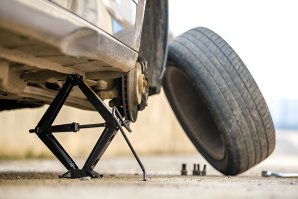Tires carry every trip you take, but the real struggle usually comes from the weather. Shifts in temperature don’t make noise, yet they slowly work against the rubber, showing up later as cracks, uneven wear, or sudden blowouts. Heat makes the air inside swell, while cold makes it shrink, and the tire has no choice but to keep adjusting. Each swing pulls on its structure and, over time, weakens it. That’s why shops offering Fort Wayne tire repair services talk about climate as much as potholes or sharp objects. Once drivers understand how weather affects tire health, they build better habits, make more intelligent choices when the seasons shift, and stay safer on the road.
How Fort Wayne Tire Repair Services Explain Heat’s Impact
In hot areas, tires change in ways most people don’t notice immediately. As the temperature climbs, the air inside expands, raising the pressure. The rubber stretches, gets softer, and loses some of its strength. You may not see this happening, but the tread wears faster and the risk of blowouts increases. Heat also burns off the oils that keep rubber flexible, leaving it drier and less forgiving. Long drives on scorching roads push tires to their limit, and if nobody checks them, failures become more likely. That’s why tire professionals urge drivers to check pressure more often during summer—it’s a small step that prevents big problems.
Cold Weather and Tire Stress
Winter flips the problem. Air contracts in the cold, so tires lose pressure and are underinflated. They press unevenly against the pavement with less air, wearing out tread in patches and cutting grip. That shortens tire life and makes braking riskier on slick roads. On top of that, the cold stiffens the rubber, making it brittle and crack-prone. As the weeks pass, minor fractures creep across sidewalls and tread, turning into weak spots. Drivers in cold regions do best when they check pressure weekly, store cars indoors when possible, and swap to winter-ready tires.
The Freeze-Thaw Cycle
Some regions get hit with the freeze-thaw problem, and it’s brutal on tires. Temps dip, air shrinks at night, and tires sag a little. By day, the heat returns, the air expands, and rubber stretches again. This constant push and pull wears on the structure in ways it wasn’t built for. Small cracks deepen each cycle, leading to leaks, stiff rubber, and sometimes complete failure. Even if the outside looks fine, the inside is taking hits. Professionals providing Fort Wayne tire repair services often compare it to concrete—solid for years, until one day it splits.
Table: Effects of Freeze-Thaw on Tires
|
Condition |
Impact on Tires |
Result Over Time |
|---|---|---|
|
Freezing nights |
Air contracts |
Underinflation |
|
Warm days |
Air expands |
Overinflation stress |
|
Daily cycles |
Rubber flexes |
Hidden cracks, weak spots |
|
Long-term exposure |
Material fatigue |
Shorter tire lifespan |
The freeze-thaw cycle doesn’t get enough attention, yet it quietly eats away at tire dependability year after year.
Road Heat vs. Air Temperature
Air temperature only tells half the story. The real danger is road heat. Asphalt, especially dark pavement, soaks up and radiates far more heat than the air around it. Tires pick it up directly as they roll across. On a hot summer day, pavement can climb past 130°F, far hotter than the air. That means tires are hit with two heat loads simultaneously: one from the inside and one from the road. This softens the tread, raises puncture risks, and stresses the belts. Long highway drives in summer speed up this damage fast, making inspections all the more critical.
Seasonal Shifts and Rubber Compounds
Tires aren’t made of just one type of rubber—they’re blends designed for balance. But no mix handles everything. Softer compounds grip better but wear fast in the heat. Harder ones hold up better in summer but get stiff and crack in winter. Without swapping tires by season, drivers deal with uneven wear, shaky handling, or tires that don’t last. That’s why repair shops recommend seasonal tires. It’s not just a sales pitch—it saves money by extending tire life. Skip this step, and you’ll likely pay for replacements sooner than expected.
Extending Tire Life in Every Season
The upside is simple: good habits make a real difference. Professionals offering Fort Wayne tire repair services usually suggest:
- Checking tire pressure weekly, especially when temperatures swing
- Looking over sidewalls for bulges, cracks, or rot
- Rotating tires every 5,000–7,000 miles to spread wear evenly
- Switching to seasonal tires for heat or cold
- Storing unused sets indoors, away from dampness or direct sunlight
These steps don’t take much but pay off in longer tire life and fewer breakdowns. Drivers save money, too, since replacements cost more than preventive care.
Humidity and Moisture Concerns
Temperature grabs the headlines, but humidity chips away quietly. Moisture slips into tiny cracks, especially when tires sit outside in damp spots. Over time, that moisture weakens the rubber, speeding up dry rot. Once cold weather comes, trapped water freezes, spreads cracks wider, and deepens damage. Leave a tire in that cycle too long, and it ends up brittle, peeling apart, or weak in the sidewalls. The trouble is, most people don’t notice until the tire suddenly fails. Simple fixes prevent most of these issues, like storing tires indoors in dry conditions.
Driving Habits That Amplify Damage
Weather sets the stage, but how someone drives decides how fast the tires wear. Hard acceleration on hot days bakes them quicker, while slamming the brakes creates hot spots that weaken the rubber. Sharp turns in cold weather stress stiff tires until they crack. Pile on heavy loads, and the pressure multiplies. All this builds on what weather already does, shaving years off a tire’s life. Drivers who ease up—smooth braking, steady speeds, lighter loads—tend to keep their tires going longer.
Conclusion
Temperature shifts beat up tires more than most drivers think. Heat expands, cold shrinks, and moisture quietly digs in from the inside. Together, they shorten life and raise risks on the road. By paying attention to advice from experts such as Roadside 24/7 Assistance, offering Fort Wayne tire repair services, drivers learn how to protect one of the most essential parts of their vehicle. With awareness, seasonal swaps, and steady care, tires last longer and work better year-round. For anyone who values safety and reliability, tire education is as essential as knowing when to refuel or change the oil.























I love sharing snacks that spark conversation, and sour watermelon gummies definitely do that. Their bright flavor is a fun talking point, and everyone seems to enjoy them instantly.